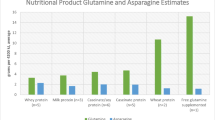Abstract
Amino acid determinations in plasma have been used for diagnostic purposes and as markers of malnutrition since the 1960s. Biochemical research has given an insight into biochemical pathways and their organ specificity, allowing better understanding of the role of amino acids in the organism. In nutrition, amino acid concentrations are used as markers of excess, deficiency or imbalance for optimising the amount and composition of proteins in prepared nutrients. For useful results to be obtained in such investigations correct timing of sampling relative to the end of food intake is essential. Using data from a study in which a reduction of protein to 1.9 g/100 kcal in starter formulas was tested, it is shown that not only does this allow amino acid concentrations quite close to those of breast-fed babies to be achieved; in addition, the levels reached with the optimised composition lead to a balance with less competition from large neutral amino acids with tryptophan transport at the blood-brain barrier (LAT1 transporter), which probably enhances the supply to the brain even when less protein is fed than in conventional formula and when there is no increase of tryptophan in the blood.
Zusammenfassung
Aminosäurenbestimmungen im Plasma werden seit den 1960ern für diagnostische Zwecke eingesetzt. Untersuchungen der biochemischen Stoffwechselwege und deren Organspezifität führten zu einem immer besseren Verständnis der Rolle der Aminosäuren im Organismus. Aminosäurenkonzentrationsbestimmungen werden benutzt, um eine Über-, Unter- oder nicht balancierte Versorgung zu erkennen und den Gehalt und die Zusammensetzung von Proteinen in Nahrungsmitteln zu optimieren. Um verwertbare Ergebnisse zu erhalten, muss der Blutentnahmezeitpunkt in Abhängigkeit von der Nahrungsaufnahme korrekt gewählt werden. Die Daten einer Untersuchung, in welcher Neugeborenen eine Milch mit reduziertem Proteingehalt (1,9 g/100 kcal), aber optimierter Zusammensetzung gegeben wurde, werden dargestellt. Mit dieser Milch ernährte Kinder zeigten gestillten Kindern vergleichbare Blutaminosäurewerte. Zudem wurde erreicht, dass die Kompetition großer neutraler Aminosäuren mit Tryptophan am Transporter der Blut-Hirn-Schranke (LAT1-Transporter) geringer war, was möglicherweise die Tryptophanversorgung des Gehirns optimierte, obwohl weniger Protein verabreicht wurde als mit konventionellen Nahrungen und obwohl keine Zunahme des Bluttryptophangehalts vorlag.



Similar content being viewed by others
References
Agostoni C, Carratu B, Boniglia C, Riva E, Sanzini E (2000) Free amino acid content in standard infant formulas: comparison with human milk. J Am Coll Nutr 19:434–438
Bachmann C, Haschke-Becher E (2002) Plasma amino acid concentrations in breast-fed and formula-fed inference and reference intervals. In: Räihä N, Rubaltelli F (eds) Infant formula: closer to the reference, vol 47, Suppl. Nestec and Lippincott Williams & Wilkins, Philadelphia, pp 121–135
Bachmann C, Nyhan WL, Kulovich S, Hornbeck ME (1975) Amino acids in the brain during fetal growth and the effects of prenatal hormonal and nutritional imbalance. In: Cheek DB (ed) Fetal and postnatal cellular growth: hormones and nutrition. Wiley & Sons, New York, pp 169–205
Bachmann C, Nyhan WL, Kulovich S, Hornbeck ME (1975) Amino acids in the plasma, muscle and liver during fetal growth and the effects of prenatal hormonal and nutritional imbalance. In: Cheek DB (ed) Fetal and postnatal cellular growth: hormones and nutrition. Wiley & Sons, New York, pp 339–79
Braissant O, Gotoh T, Loup M, Mori M, Bachmann C (2001) Differential expression of the cationic amino acid transporter 2(B) in the adult rat brain. Brain Res Mol Brain Res 91:189–195
Bruhat A, Jousse C, Wang XZ, Ron D, Ferrara M, Fafournoux P (1997) Amino acid limitation induces expression of CHOP, a CCAAT/enhancer binding protein-related gene, at both transcriptional and post-transcriptional levels. J Biol Chem 272:17.588–17.593
Bruhat A, Jousse C, Fafournoux P (1999) Amino acid limitation regulates gene expression. Proc Nutr Soc 58:625–632
Endo Y, Fu Z, Abe K, Arai S, Kato H (2002) Dietary protein quantity and quality affect rat hepatic gene expression. J Nutr 132:3632–3637
Gaull GE, Rassin DK, Räihä NC, Heinonen K (1977) Milk protein quantity and quality in low-birth-weight infants. III. Effects on sulfur amino acids in plasma and urine. J Pediatr 90:348–355
Kim YH, Kim DU, Han KH, Jung JY, Sands JM, Knepper MA, Madsen KM, Kim J (2002) Expression of urea transporters in the developing rat kidney. Am J Physiol Renal Physiol 282: F530–540
Miller LP, Pardridge WM, Braun LD, Oldendorf WH (1985) Kinetic constants for blood-brain barrier amino acid transport in conscious rats. J Neurochem 45:1427–1432
Räihä NC, Fazzolari_Nesci A, Boehm G (1996) Taurine supplementation prevents hyperaminoacidemia in growing term infants fed high-protein cow's milk formula. Acta Paediatr 85:1403–1407
Räihä NC, Fazzolari-Nesci A, Cajozzo C, Puccio G, Monestier A, Moro G, Minoli I, Haschke-Becher E, Bachmann C, Hof MV, Fassler AL, Haschke F (2002) Whey predominant, whey modified infant formula with protein/energy ratio of 1.8 g/100 kcal: adequate and safe for term infants from birth to four months. J Pediatr Gastroenterol Nutr 35:275–281
Sturman JA, Rassin DK, Gaull GE (1977) Taurine in developing rat brain: maternal-fetal transfer of [35 S] taurine and its fate in the neonate. J Neurochem 28:31–39
Sturman JA, Rassin DK, Gaull GE (1977) Taurine in developing rat brain: transfer of [35S] taurine to pups via the milk. Pediatr Res 11:28–33
Wurtman RJ, Wurtman JJ, Regan MM, McDermott JM, Tsay RH, Breu JJ (2003) Effects of normal meals rich in carbohydrates or proteins on plasma tryptophan and tyrosine ratios. Am J Clin Nutr 77:128–132
Ziegler EE (1974) Sodium, chloride, potassium; renal solute load and problems of water balance in the nutrition of infants. Monatsschr Kinderheilkd Suppl 122:279–284
Ziegler EE, Fomon SJ (1971) Fluid intake, renal solute load, and water balance in infancy. J Pediatr 78:561–568
Ziegler EE, Fomon SJ (1989) Potential renal solute load of infant formulas. J Nutr 119:1785–1788
Author information
Authors and Affiliations
Corresponding author
Rights and permissions
About this article
Cite this article
Bachmann, C. Plasma amino acids as substrates and nutrition-dependent markers. Monatsschr Kinderheilkd 151 (Suppl 1), S72–S77 (2003). https://doi.org/10.1007/s00112-003-0793-z
Published:
Issue Date:
DOI: https://doi.org/10.1007/s00112-003-0793-z




